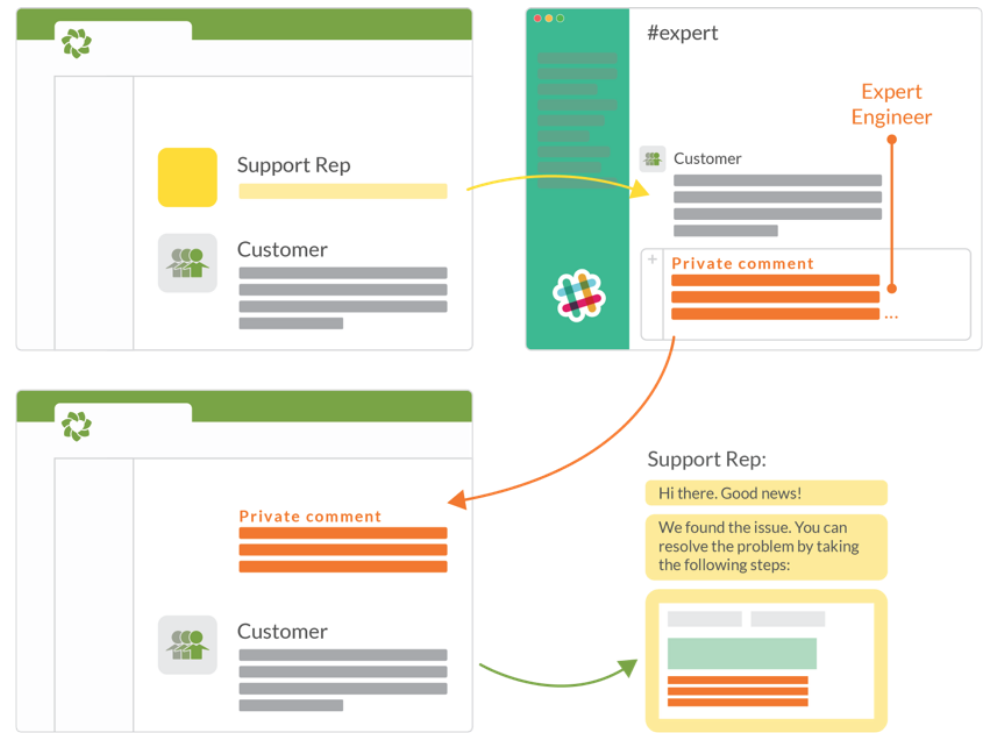Our VP of Business Development, Markus Zirn, discusses two of the biggest trends in tech – Slack and AI – and how Workato brings them together to create the future of work.
Trend 1: Slack, the new “Office OS”
Slack’s growth is record-breaking
According to the latest okta survey, Slack is the #1 fastest cloud application in enterprises with a 77% growth rate. Slack enables team communication by providing chat rooms, organized by themes, as well as offer private messaging and private group messages. In May 2016, it counted 3M daily active users. There’s no question that Slack has become nothing short of a movement to bring team communication to the 21st century.
Is Slack just a chat platform?
Sure, the chat and channel functions are pretty great, but they’re hardly groundbreaking. It’s the integrations with their app notifications that actually make work life easier. In Slack, applications chat just as much as people do. And integrations are just the beginning of something much bigger. In the article “Slack and the New Model for Business Process Software,” April Underwood, Head of Platform at Slack highlights the command center-like role of Slack as transforming business process and workflows within collaborative teams. “Often a business team might start with Trello or a Google Doc and then the design team starts building in InDesign, then engineering uses GitHub,” Underwood says. “Slack really provides the space from start to finish for the steps in the product development process: that’s the concrete way that Slack is changing how teams work.”
Slack is transforming the business process software market
Slack is much more than a chat tool. For now, Slack has become central to the developer workflow, but it has the potential to transform the whole business process software market. It can be the glue between multiple disparate applications and hence, you can call it the new operating system of an office!
Mountains of data in siloed business applications
But what about business apps? Business applications may be the last fortresses in a world where communication and coordination has undergone disruption. We’ve built up mountains of data in siloed business applications like Salesforce, Zendesk, and ServiceNow that automate standard business tasks. However, designed in the client server era, business applications are built for and priced by the named users that access them through dedicated user interfaces – somewhat exclusive, closed off islands where key business data is hidden away. Each one of them has its own login and data structure. Accessing the applications’ APIs is still only for the most technically savvy. Hence, only small groups of employees participate in each business application.
Let’s connect business applications with Slack
Isn’t it time that business applications also make use of the 21st century employee communication infrastructure? Tom Tunguz explains in “The New UI for SaaS” how chat platforms like Slack can provide a more appealing interface for business applications.
What if the world of business applications was more inclusive and every employee with access to Slack could contribute to business processes? What if key business data was available right where employees spend the most time communicating?
Let’s take a look at a concrete Zendesk customer support scenario. The first line support rep can’t resolve every single customer question. Some questions will inevitably require the assistance of an expert engineer. Very likely, this engineer spends most of their time in Slack communicating with their team of other engineers. In order to resolve these issues efficiently, it is key to make it easy for that engineer to contribute. Imagine questions were posted the appropriate Slack channel and the engineers could respond right there while that response was brought back to Zendesk as a private comment that the first line support rep can use to get back to the customer.
Workato’s Workbot – disrupt without needing to code
Interested in reaping the same benefits in your customer support process? With Workato’s Workbot, it’s easy to set up without any coding required. All it takes is 2 Workato integration scripts (also called recipes). The first one posts the customer’s question into the appropriate Slack channel. Workato’s Workbot kicks off the second recipe when the engineer responds in Slack and automatically brings the answer right back to Zendesk as a private comment.
Workato can do the same for easily retrieving data from business applications within Slack. Imagine you want to have a quick 360 overview of everything your business applications know about a specific customer. Using Workbot, just create a recipe that goes to your CRM, Support and Accounting apps and pulls all the necessary info and then displays it in Slack. You can even visualize data with simple charts in Slack. You’ll have everything at your fingertips without ever leaving Slack.
Trend 2: AI – now accessible with ease
AI is one of the hottest topics in enterprise software
Deloitte predicts more than 80 of the world’s 100 largest enterprise software companies will have integrated cognitive technologies into their products by the end of 2016. Accordingly, the market for enterprise AI applications is projected to increase at a staggering compound annual growth rate (CAGR) of 56%. This immense growth rate is quickly making AI one of the hottest topics in enterprise software and enterprise AI is on the way to becoming an arms race across all industries. It seems safe to say that in the future everything will be powered by AI.
IBM Watson has made AI accessible
With its “free to experiment with” services, IBM Watson has made an important step forward to finally deliver on the dream of Artificial Intelligence. Business applications rely on relational databases which are optimized for structured data, not for analyzing unstructured data such as text. However, with IBM Watson, analyzing unstructured text for sentiment and classification is now as easy as calling a REST service. We’re closer than ever before to make our business applications smart and bring artificial intelligence to our business processes.
The Future of Work – with Slack & AI
The “double whammy” of combining Slack with AI
Having a new “Office OS” with Slack and accessible AI are super powerful trends of their own. But what if you combine them together? To explore that potential, Workato, together with system integrator Advantage Integrated and customer LinkedIn, participated in the recent Creatorcon hackathon held at ServiceNow’s Knowledge16 conference. The result, which you can watch in this video, demonstrates how Workato’s integration and automation platform orchestrates Slack and IBM Watson to complement ServiceNow. As Martin Barclay, Director of Product Marketing, Store and Developer at ServiceNow put it in a recent podcast on Workato: “To me, Workato is integration made agile. It’s like IFTTT for the Enterprise. At our Creatorcon hackathon, Workato created a really cool integration between the brand new ServiceNow Helsinki release, Slack and IBM Watson and was able to crowdsource smart customer support in less than 8 hours”.
How intelligent team sourcing works
Crowdsourcing (or teamsourcing) smart customer support…how does this work? Well, IBM Watson’s artificial intelligence analyzes the support question submitted in ServiceNow for sentiment and classifies it. Should it be prioritized because the customer is frustrated or demonstrates a sense of urgency? Classification is applied to select the best possible experts from a large pool stored in ServiceNow. Then, an ad-hoc Slack channel is created and populated with these suitable experts. Their collaborative response is brought back to ServiceNow.
The result: available employee experts are included intelligently and power a much more responsive, high quality and lower cost support.
In less than 8 hours? How’s this possible?
It’s fun to change the world in a hackathon evening over pizza and beer. It definitely kept our team going that night. After all, In our daily lives, Uber and Airbnb have demonstrated how smart, large scale collaboration of resources can “change the game” and serve consumer much better than the old world of taxis and hotels. We were doing the very same, just for customer service.
Thanks to Workato, all of this could be expressed as only 2 integration recipes and without any coding. Impressive! Take a look at recipe number 1: in row 2, IBM Watson’s sentiment response is visualized as a pie chart and sentiment appended in ServiceNow in row 3. In rows 9 to 13, all experts in ServiceNow are checked and only the ones that match IBM Watson’s classification are populated in the ad-hoc Slack channel. Powerful, right? Yet easy enough to understand. Recipe 2 brings the collaborative expert response from the ad hoc Slack channel back to ServiceNow via Workato’s Workbot.
The net, net: You can do this yourself with Workato….and you don’t have to be a developer.
The Future of Work at Your Company
Imagine how you can apply these hackathon project learnings and bring “the future of work” to your own business applications: Include the right experts at the right step of a sales cycle, collaboratively resolve project hurdles on development or services projects, improve your lead qualification process….Imagine what intelligent team sourcing can do for you! You may also want to talk to a Slack pioneer turned consultant, like Alex Godin of Slash-Hyphen, to better understand Slack’s potential for your business processes.
As you learned, Workato’s Workbot help implements such workflows across Slack and applications very easily – without writing a single line of code – and exactly how you need them for your company. Implementing very disruptive business process improvements can be simplified down to connecting up Slack – the new “Office OS”, IBM Watson and your business applications with Workato.
Sign up for a free Workato trial online; or just contact me at markus@workato.com if you want to experience the “Future of Work” in your company.

